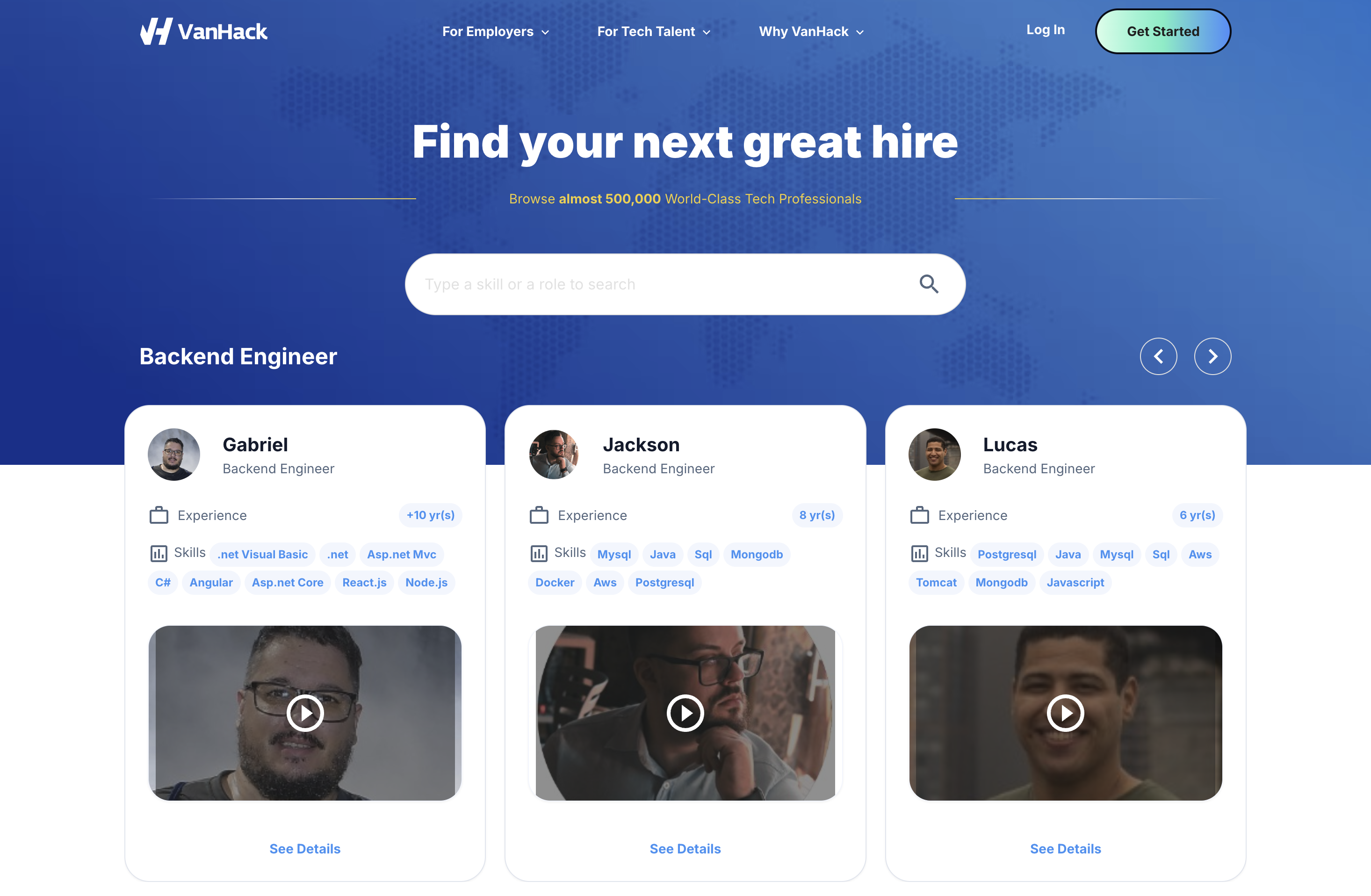Finding skilled SQL developers in the US often means facing high costs and stiff competition. Latin America offers a strong alternative with a large pool of capable professionals, lower salary ranges, convenient time zone alignment, and solid English skills. This guide shares 7 straightforward strategies to hire remote SQL developers from LATAM, covering effective outreach and partnering with recruitment experts. Discover how to access this talent efficiently by connecting with VanHack.
Why Hire Remote SQL Developers from Latin America?
Latin America stands out for US companies due to notable cost savings, skilled professionals, and compatibility with US work schedules.
Significant Cost Savings on Salaries
Hiring SQL developers from LATAM can cut costs considerably. In 2025, annual salaries in the region are much lower than in the US, where developers typically earn between $60,000 and $140,000. In Brazil, salaries range from $13,000 to $35,000, in Argentina from $9,000 to $25,000, and in Colombia from $15,000 to $27,500, based on experience. This translates to savings of 60 to 75 percent.
Breaking it down by experience, junior developers in Brazil earn $13,000 to $17,000, mid-level ones $17,000 to $25,000, and senior developers $25,000 to $35,000. In Argentina, the ranges are $9,000 to $12,000 for juniors, $12,000 to $17,000 for mid-level, and $17,000 to $25,000 for seniors. These numbers allow companies to hire more talent for the same budget or redirect funds to other priorities.
Skilled Professionals with Current Expertise
LATAM developers bring strong skills in database tools like T-SQL, PL/SQL, MySQL, and PostgreSQL, along with experience in remote work and Agile methods. Their technical background matches US standards, enabling them to contribute effectively from day one.
The region’s focus on tech education and growing industry has created a workforce adept in both classic database management and modern cloud solutions. Many developers also have hands-on experience with data warehousing and business intelligence tools, adding value to complex projects.
Convenient Time Zone Alignment and Clear Communication
Most LATAM countries, including Mexico, Brazil, and Colombia, share overlapping work hours with US Eastern and Central time zones. This makes real-time collaboration feasible for meetings and problem-solving, unlike regions with larger time differences.
Communication is also smoother with many LATAM developers speaking English well and understanding US business practices. This reduces misunderstandings and helps them blend into US-based teams with ease. Want to tap into this talent pool? Explore options with VanHack to build your team.
7 Steps to Hire Remote SQL Developers from LATAM
1. Craft Job Descriptions for a Global Reach
Make job postings appealing to international talent by focusing on universal skills and remote work benefits instead of US-specific details. Highlight technical challenges and growth opportunities to attract LATAM developers eager for remote roles.
This approach not only draws candidates but also filters for those suited to cross-cultural remote work, saving time on mismatched applicants.
Key Actions:
- Use remote-friendly language, focusing on flexible tools and schedules.
- Emphasize project impact over regional experience.
- Highlight learning opportunities and access to new tech.
- Keep language simple and avoid local slang.
- State specific time zone overlap needs clearly.
2. Research Local Pay and Offer Competitive Packages
Understand salary ranges in LATAM to create offers that appeal to local talent while staying budget-friendly. It’s about finding a balance where your compensation is attractive in their market and still saves you money compared to US rates.
Beyond salary, consider adding value with benefits like flexible hours or professional growth options, which often matter more to LATAM developers than just a higher paycheck.
Key Actions:
- Check current pay rates in LATAM using reliable data.
- Combine fair base pay with bonuses and growth stipends.
- Offer support for remote setups, like internet or equipment allowances.
- Account for local currency and cost of living in pay plans.
- Outline clear career growth paths with pay increases.
VanHack connects you with over 500,000 tech professionals worldwide, including LATAM talent, to help design appealing compensation packages.
3. Use Targeted Recruitment Platforms with AI Tools
General job boards can overwhelm with applications when hiring abroad. Platforms using AI to match and screen candidates streamline the process, cutting through unqualified entries and providing detailed insights beyond resumes.
This shift saves weeks of manual review, letting you focus on deeper interviews with candidates already vetted for skills and fit.
Key Actions:
- Choose platforms with advanced matching over basic keyword searches.
- Look for built-in assessments like video intros and coding tests.
- Check the platform’s reach in specific LATAM countries.
- Consider subscription plans for ongoing hiring needs.
- Ensure integration with your current HR tools.
VanHack specializes in sourcing remote SQL developers from LATAM. With its AI recruiter “Vanna,” it provides a shortlist of 3-5 pre-vetted candidates per role, complete with video intros, technical interview recordings, and coding test scores. Start hiring efficiently by partnering with VanHack.

4. Set Up a Thorough Vetting Process for Skills and Fit
A detailed evaluation tailored for remote hiring helps find developers with the right technical and communication abilities for distributed teams. Standard resume checks often miss deeper insights into a candidate’s true potential.
Investing in a solid vetting process upfront boosts long-term team performance and reduces the risk of costly hiring mistakes.
Key Actions:
- Start with video submissions to assess communication and English skills.
- Use coding tests for SQL and database design knowledge.
- Review recorded technical interviews for problem-solving skills.
- Hold live interviews with real-world scenarios.
- Add behavioral checks for remote work readiness and team fit.
- Test practical skills with job-related tasks.
5. Focus on Effective Remote Onboarding
A clear onboarding plan turns new hires into productive team members quickly, especially in remote, cross-cultural setups. The early weeks shape their experience and impact both output and retention.
Good onboarding cuts the learning curve and builds connections, helping new developers feel supported and clear on their role.
Key Actions:
- Provide digital welcome kits with company info and remote tips.
- Pair new hires with mentors for the first 30-60 days.
- Plan regular check-ins with managers and peers early on.
- Set up tools and access before their start date.
- Arrange casual virtual meetups for team bonding.
- Define communication expectations, like response times.
6. Handle Legal and Payroll Compliance with Expert Help
Hiring internationally comes with varied legal, tax, and labor rules by country, which can lead to penalties if ignored. Navigating this complexity often requires outside expertise for companies without global HR teams.
Proper compliance protects both your business and employees, setting a foundation for scalable international hiring.
Key Actions:
- Explore Employer of Record services for simpler hiring without a local entity.
- Work with legal experts on LATAM country-specific rules.
- Draft contracts aligned with local labor laws.
- Set up correct tax and reporting systems.
- Follow US and local data privacy standards.
- Keep thorough records for all requirements.
For relocation needs, VanHack’s Global Mobility team assists with visas, housing, and other logistics. Simplify global expansion by working with VanHack.
7. Build an Inclusive Environment for Remote Teams
Creating a cohesive remote team across cultures takes effort to ensure understanding and open communication. Differences in work styles can be a strength if managed well.
An inclusive setup improves teamwork, output, and satisfaction, often leading to creative solutions from diverse viewpoints.
Key Actions:
- Use tools like Slack or Jira for flexible, time zone-friendly updates.
- Train staff on cultural differences for better collaboration.
- Hold video calls for both work and personal connection.
- Recognize varied holidays and events for inclusivity.
- Set communication norms respecting different styles.
- Create channels for all voices to be heard.
- Offer mentorship to support LATAM hires professionally.
Comparing VanHack to Other Recruitment Methods for LATAM SQL Developers
|
Feature |
VanHack |
Traditional Agency |
DIY Hiring |
|
Talent Sourcing |
Pre-vetted, 500K+ global pool, AI-matched shortlist (3-5) |
Manual search, limited networks |
Job boards, hundreds of applications |
|
Vetting Process |
Video intros, AI tech interviews, coding tests |
Resume screen, basic phone interviews |
Manual screening, time-intensive |
|
Cost Model |
Subscription ($3k/month unlimited hires) or success fee |
High per-hire fees (15-30% salary) |
Internal resource cost, platform fees |
|
Time-to-Hire |
Faster with pre-qualified candidates |
Longer due to traditional process |
Extended due to manual effort |
Enhancing Results with Advanced LATAM Hiring Tactics
Top companies go beyond basics, adopting extra steps to stand out and attract the best SQL developers in Latin America’s competitive market.
Develop Ongoing Talent Connections
View LATAM hiring as a continuous strategy, not one-off hires. Build ties with skilled developers even without open roles, creating a pipeline for future needs.
Stay in touch with strong past candidates, offer feedback, and encourage referrals from current staff to maintain an edge in accessing top talent.
Encourage Team Referrals and Advocacy
Your LATAM employees can be your best recruiters locally. Their genuine experiences with your company can attract others in their network who aren’t actively looking.
Set up referral programs with fair rewards, ensuring referred candidates get proper consideration during hiring.
Embrace Diverse Skills and Backgrounds
Cost savings are a start, but the real benefit lies in varied perspectives from LATAM developers. Hiring from different countries brings unique approaches to technical work.
Target multiple LATAM regions to gain this diversity and reduce risks tied to single-country challenges like economic shifts.
Addressing Common Hiring Challenges in LATAM
Being prepared for typical issues ensures a smoother process and better results for everyone involved.
Managing Time Zone Differences
Even with good overlap, coordinating across time zones can be tricky if teams are spread out. Define core hours for collaboration that suit everyone while respecting personal time.
Use scheduling tools to handle time differences and rotate meeting times fairly. Share key updates in written form so absent team members stay informed.
Handling Currency Changes in Pay
Fluctuating local currencies in some LATAM countries can affect compensation. Offering pay in USD or using protective measures can stabilize income for developers.
Design packages with safeguarded base pay and performance bonuses to balance security and motivation.
Supporting Career Growth Remotely
LATAM developers may worry about growth compared to US-based peers. Provide clear paths for advancement, training access, and equal project opportunities.
Offer mentorship, conference funds, and certification support to show commitment to their development, boosting retention.
Tracking Success in LATAM SQL Developer Hiring
Measure outcomes with specific metrics to refine your international hiring approach over time.
Hiring Speed and Candidate Quality
Monitor the time from posting to hire for LATAM roles versus US ones. Evaluate quality through test scores, manager feedback, and early performance reviews to ensure standards are met.
Retention and Team Engagement
Compare retention, promotions, and engagement levels of LATAM staff to company averages. Strong numbers reflect successful integration, while gaps highlight areas to improve.
Cost and Return on Investment
Calculate hiring costs, including platform fees and onboarding, against US hiring expenses. Factor in salary savings to confirm the financial benefits of LATAM hires.
Ready to access skilled LATAM developers for your team? Begin with VanHack to streamline your recruitment process.
Common Questions About Hiring LATAM SQL Developers
How Do Senior SQL Developer Salaries Compare Between LATAM and the US?
In the US, senior SQL developers earn $60,000 to $140,000 yearly. In LATAM, the range is much lower, with Brazil at $25,000 to $35,000, Argentina at $17,000 to $25,000, and Colombia at $22,500 to $27,500. This 60 to 75 percent difference allows US companies to hire multiple seniors for the cost of one local hire, reflecting market and living cost variations, not skill levels.
How Does VanHack Verify Skills and English Levels of LATAM Developers?
VanHack uses a multi-step vetting process. Candidates submit video introductions to assess communication and English ability. AI-driven technical interviews, lasting 30 minutes, are recorded with transcripts and scores. Coding tests on standard platforms provide clear skill data, ensuring only qualified developers advance.
What Cultural Differences Might Arise with LATAM Developers, and How Can They Be Managed?
LATAM developers often value relationships and may communicate less directly than US norms. Set clear communication rules, train teams on cultural nuances, and foster inclusive spaces with regular video chats and bonding activities. Their English proficiency and remote experience typically minimize any friction.
Is Hiring LATAM Developers Affordable for Small US Startups?
Yes, it’s often a smart financial move for startups. Salary savings of 60 to 75 percent usually offset extras like payroll services or platform costs. VanHack’s $3,000 monthly subscription for unlimited hires offers an economical way to build teams.
How Do Time Zones Impact Working with LATAM Developers?
Time differences are minor compared to other global regions. Most LATAM countries overlap by 2 to 4 hours with US business hours, supporting real-time teamwork. Mexico and Colombia align with Central time, while Brazil and Argentina match Eastern time well. Set shared working hours and use async tools for flexibility.
Final Thoughts on Building Teams with LATAM Talent
Hiring SQL developers from Latin America offers more than cost reductions. It’s a chance to create diverse, capable teams while managing budgets better. The mix of lower salaries, skilled talent, time zone alignment, and communication strengths makes LATAM a prime choice for scaling tech teams.
Success requires focused efforts in crafting job postings, setting fair pay, thorough screening, and team integration. Companies using these seven strategies, paired with expert recruitment support, gain a lasting edge in hiring.
The numbers speak clearly: LATAM hiring can save 60 to 75 percent on talent costs without sacrificing quality. Time zone and cultural compatibility ensure smooth collaboration. The region’s tech growth continues to produce developers ready for modern challenges and remote work.
If you’re a startup building a team or a growing company scaling up, Latin America has the talent and practicality to meet your needs. Ready to start? Connect with VanHack to tap into top SQL developers and drive your business forward with a tailored, AI-supported hiring solution.



